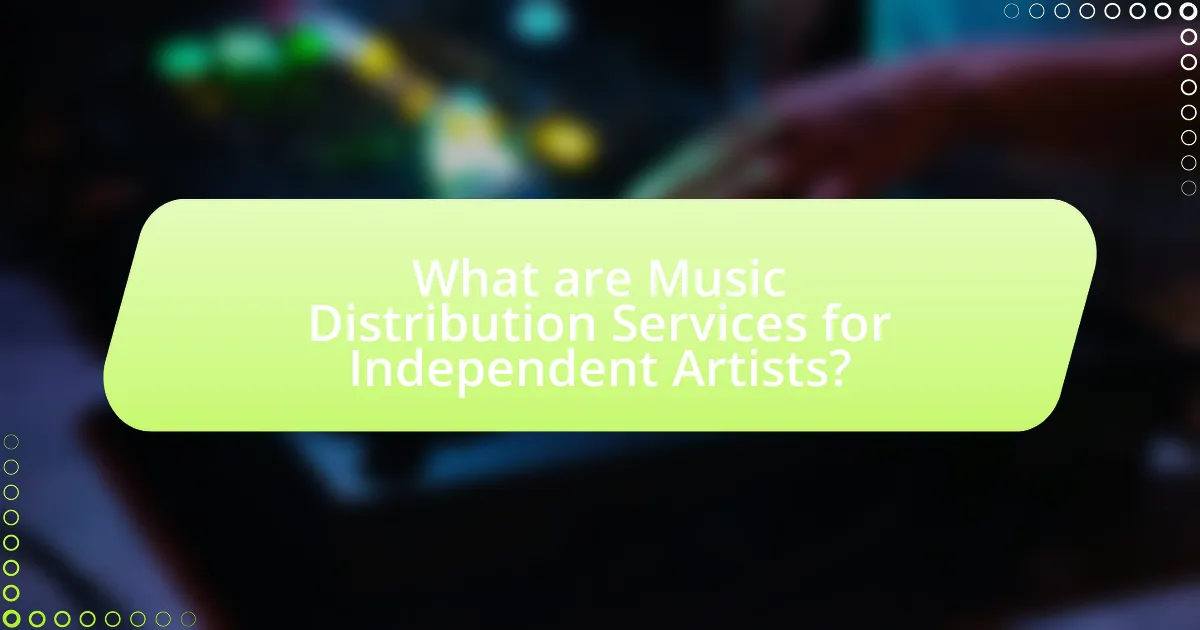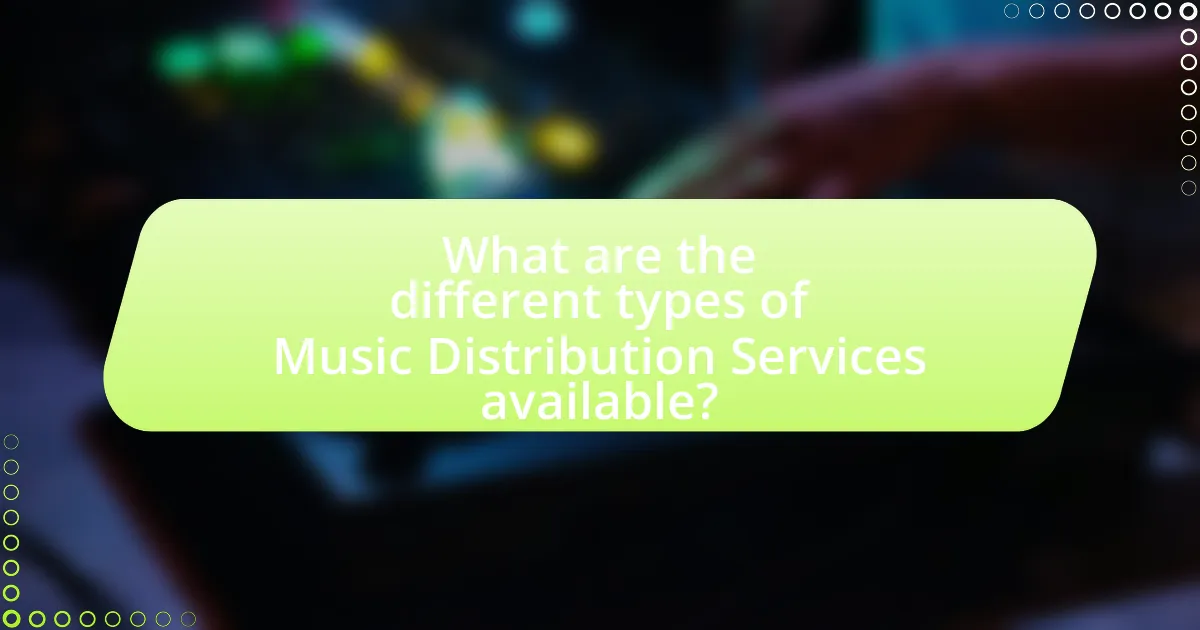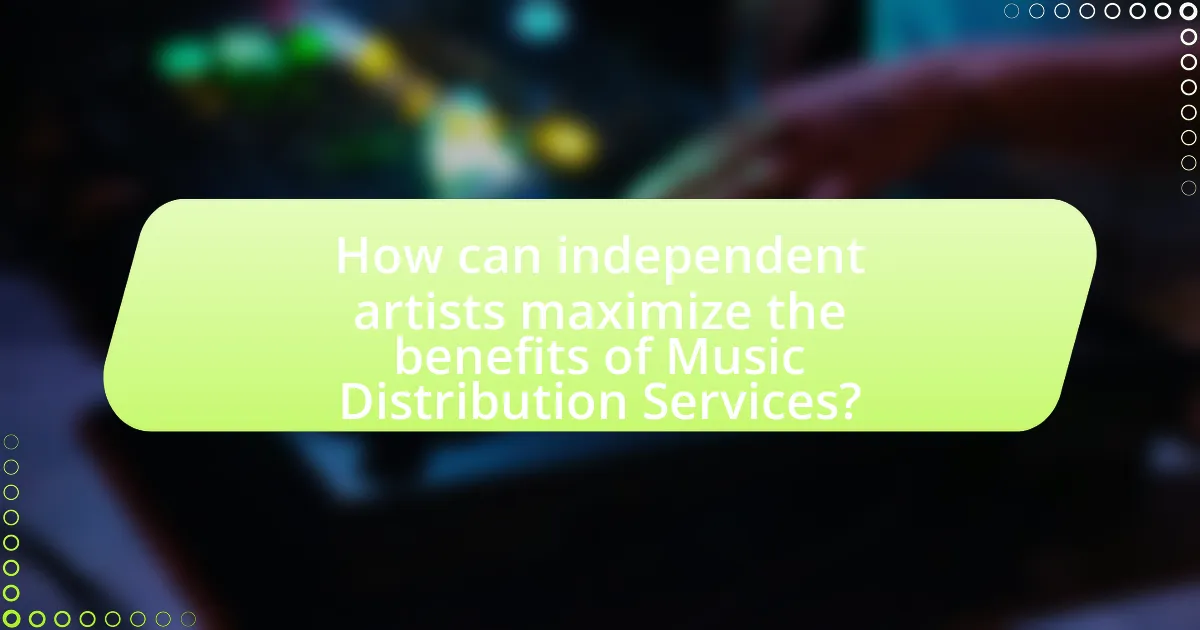Music distribution services are essential platforms for independent artists, enabling them to release and promote their music on major digital streaming services and online stores. These services facilitate the upload, management, and distribution of music, ensuring artists can reach global audiences without traditional record labels. Key features include royalty collection, marketing tools, and analytics, which collectively enhance visibility and financial sustainability. The article explores the various types of distribution services, their advantages, and best practices for independent artists to maximize their benefits while avoiding common pitfalls.

What are Music Distribution Services for Independent Artists?
Music distribution services for independent artists are platforms that facilitate the release and promotion of music to digital streaming services and online stores. These services enable artists to upload their music, manage their catalog, and ensure their tracks are available on platforms like Spotify, Apple Music, and Amazon Music. According to a report by the International Federation of the Phonographic Industry (IFPI), digital music distribution has become essential for independent artists, as it allows them to reach global audiences without the need for traditional record labels.
How do Music Distribution Services function?
Music distribution services function by facilitating the delivery of music from artists to various digital platforms, such as Spotify, Apple Music, and Amazon Music. These services act as intermediaries, allowing independent artists to upload their music, which is then distributed to multiple streaming services and online stores.
Typically, artists create an account with a distribution service, upload their tracks, and provide necessary metadata, such as song titles and album art. The distribution service then encodes the music files and ensures they meet the technical requirements of each platform. Once the music is uploaded, the service manages the licensing, royalty collection, and reporting, allowing artists to receive payments based on streams and downloads.
For instance, services like DistroKid and TuneCore have streamlined this process, enabling artists to reach global audiences without the need for traditional record labels. According to a report by the International Federation of the Phonographic Industry (IFPI), digital music revenues grew by 19.9% in 2020, highlighting the increasing reliance on distribution services for independent artists to monetize their work effectively.
What are the key features of Music Distribution Services?
Music distribution services primarily offer digital distribution, allowing artists to release their music on major streaming platforms like Spotify, Apple Music, and Amazon Music. These services also provide royalty collection, ensuring that artists receive payments for their streams and downloads. Additionally, they often include marketing tools, such as playlist pitching and social media promotion, to enhance visibility. Furthermore, many distribution services offer analytics, giving artists insights into their audience and performance metrics. These features collectively empower independent artists to reach wider audiences and manage their music careers effectively.
How do these features support independent artists?
Music distribution services support independent artists by providing them with access to global platforms for their music, enabling wider reach and audience engagement. These services facilitate the distribution of music to major streaming platforms like Spotify and Apple Music, which are essential for visibility in a competitive market. Additionally, they often offer tools for analytics, allowing artists to track listener demographics and engagement, which can inform marketing strategies. According to a 2021 report by MIDiA Research, independent artists who utilize distribution services see a 30% increase in streaming revenue compared to those who do not. This data underscores the critical role that these features play in enhancing the financial viability and exposure of independent artists.
Why are Music Distribution Services essential for independent artists?
Music distribution services are essential for independent artists because they facilitate the release and promotion of music across various platforms, ensuring wider audience reach. These services enable artists to distribute their music to major streaming platforms like Spotify, Apple Music, and Amazon Music, which collectively account for over 80% of music consumption globally. By utilizing these services, independent artists can gain access to analytics and marketing tools that help them understand their audience and optimize their promotional strategies. Furthermore, music distribution services often handle royalty collection, ensuring that artists receive fair compensation for their work, which is crucial for their financial sustainability in a competitive industry.
What challenges do independent artists face without distribution services?
Independent artists face significant challenges without distribution services, primarily limited access to major streaming platforms and reduced visibility. Without distribution, artists struggle to reach a wider audience, as platforms like Spotify and Apple Music typically require a distributor for content to be available. This lack of access can lead to lower streaming numbers and diminished revenue opportunities. Additionally, independent artists may encounter difficulties in marketing their music effectively, as distribution services often provide promotional tools and support that enhance visibility. Furthermore, without these services, artists are responsible for managing their own sales and logistics, which can be overwhelming and detract from their creative focus.
How do distribution services enhance visibility for independent artists?
Distribution services enhance visibility for independent artists by providing access to major streaming platforms and digital marketplaces. These services enable artists to distribute their music widely, reaching audiences that would be difficult to access independently. For instance, platforms like Spotify and Apple Music have millions of users, and distribution services ensure that independent artists’ music is available on these platforms, increasing their chances of being discovered. Additionally, many distribution services offer promotional tools and analytics, allowing artists to track their performance and optimize their marketing strategies. This combination of broad access and targeted promotion significantly boosts the visibility of independent artists in a competitive music landscape.

What are the different types of Music Distribution Services available?
There are several types of music distribution services available, including digital distribution, physical distribution, and direct-to-fan distribution. Digital distribution services, such as DistroKid, TuneCore, and CD Baby, allow artists to upload their music to streaming platforms like Spotify, Apple Music, and Amazon Music. Physical distribution involves the production and distribution of physical copies of music, such as CDs and vinyl, often managed by companies like Alliance Entertainment. Direct-to-fan distribution enables artists to sell their music directly to fans through platforms like Bandcamp and their own websites, fostering a closer connection with their audience. Each type of service caters to different needs and preferences of independent artists, facilitating their reach and sales in the music industry.
How do digital distribution services differ from physical distribution?
Digital distribution services differ from physical distribution primarily in their delivery method and accessibility. Digital distribution allows for instant access to music through online platforms, enabling artists to reach global audiences without the need for physical inventory or shipping logistics. In contrast, physical distribution involves tangible products, such as CDs or vinyl records, which require manufacturing, storage, and transportation, often leading to higher costs and longer timeframes for reaching consumers. The rise of digital platforms, such as Spotify and Apple Music, has transformed the music industry, with over 80% of music revenue now generated from digital sources, highlighting the efficiency and scalability of digital distribution compared to traditional physical methods.
What are the advantages of digital distribution for independent artists?
Digital distribution offers independent artists significant advantages, including broader reach, cost-effectiveness, and control over their music. By utilizing platforms like Spotify and Apple Music, independent artists can access global audiences without the need for traditional record labels, which often limit exposure. According to a 2021 report by the International Federation of the Phonographic Industry, digital music revenues accounted for 62% of the global recorded music market, highlighting the importance of digital channels for artist visibility. Additionally, digital distribution typically incurs lower costs compared to physical distribution, allowing artists to retain a larger share of their earnings. This model empowers artists to maintain creative control over their work, enabling them to make decisions regarding pricing, marketing, and release schedules.
What role does physical distribution play in an artist’s strategy?
Physical distribution is crucial in an artist’s strategy as it directly impacts their market reach and revenue generation. By utilizing physical distribution channels, artists can ensure their music is available in retail stores, which enhances visibility and accessibility to potential fans. This strategy is supported by the fact that physical sales, including vinyl and CDs, accounted for 18% of total music revenue in the U.S. in 2022, according to the Recording Industry Association of America. Therefore, effective physical distribution not only broadens an artist’s audience but also contributes significantly to their overall financial success.
What are the leading Music Distribution Services for independent artists?
The leading music distribution services for independent artists include DistroKid, TuneCore, CD Baby, and Amuse. DistroKid is known for its fast distribution and affordable pricing, allowing artists to keep 100% of their royalties. TuneCore offers comprehensive services, including publishing administration, and charges per release. CD Baby provides a wide range of distribution options and additional services like CD and vinyl sales. Amuse stands out with its free distribution model and artist-friendly features. These services are widely recognized in the industry for their effectiveness in helping independent artists reach global audiences and monetize their music.
How do these services compare in terms of pricing and features?
Music distribution services vary significantly in pricing and features. For instance, DistroKid offers unlimited uploads for a flat annual fee starting at $19.99, while TuneCore charges per release, with fees around $9.99 for a single and $29.99 for an album. In terms of features, DistroKid provides services like automatic revenue splitting and YouTube monetization, whereas TuneCore offers detailed sales reports and publishing administration. These differences highlight how independent artists can choose a service based on their budget and specific needs, such as the frequency of releases or the importance of detailed analytics.
What unique offerings do specific services provide to independent artists?
Specific services provide independent artists with unique offerings such as digital distribution, marketing tools, and analytics. Digital distribution allows artists to release their music on major streaming platforms like Spotify and Apple Music, increasing their reach and accessibility. Marketing tools, including social media promotion and playlist placements, help artists gain visibility and connect with their audience effectively. Analytics provide insights into listener demographics and engagement, enabling artists to make informed decisions about their marketing strategies and future releases. These offerings collectively empower independent artists to manage their careers more effectively in a competitive music landscape.

How can independent artists maximize the benefits of Music Distribution Services?
Independent artists can maximize the benefits of Music Distribution Services by selecting the right distribution platform that aligns with their goals and actively promoting their music across various channels. Choosing a distribution service that offers wide reach, competitive royalty rates, and additional promotional tools enables artists to effectively distribute their music to major streaming platforms like Spotify and Apple Music. Furthermore, engaging in social media marketing, utilizing email newsletters, and collaborating with influencers can enhance visibility and drive traffic to their music. According to a 2021 report by the International Federation of the Phonographic Industry, independent artists who actively promote their releases see a 30% increase in streaming numbers compared to those who do not engage in promotional activities.
What strategies should independent artists employ when choosing a distribution service?
Independent artists should prioritize transparency, cost-effectiveness, and reach when choosing a distribution service. Transparency ensures that artists understand the terms, fees, and revenue splits, which is crucial for financial planning. Cost-effectiveness involves evaluating the pricing structure, including upfront fees and commission rates, to maximize earnings. Reach is essential as it determines the platforms where the music will be available; artists should select services that distribute to major streaming platforms like Spotify, Apple Music, and others. According to a 2021 report by MIDiA Research, artists who utilize comprehensive distribution services can increase their audience engagement by up to 30%, highlighting the importance of choosing the right service for broader exposure.
How can artists leverage analytics provided by distribution services?
Artists can leverage analytics provided by distribution services to gain insights into their audience’s behavior and preferences. By analyzing data such as streaming numbers, geographic locations of listeners, and demographic information, artists can tailor their marketing strategies and promotional efforts more effectively. For instance, if analytics reveal that a significant portion of an artist’s audience is located in a specific region, the artist can plan targeted tours or localized marketing campaigns to engage that audience. Additionally, understanding which songs perform best can inform future songwriting and production decisions, ultimately enhancing an artist’s overall career trajectory.
What promotional tactics can enhance the effectiveness of distribution services?
Promotional tactics that can enhance the effectiveness of distribution services include targeted social media advertising, influencer partnerships, and email marketing campaigns. Targeted social media advertising allows independent artists to reach specific demographics, increasing visibility and engagement with potential listeners. Influencer partnerships leverage the established audiences of influencers to promote music, creating authentic connections and expanding reach. Email marketing campaigns enable direct communication with fans, providing updates on new releases and exclusive content, which fosters loyalty and encourages sharing. These tactics have been shown to significantly increase streaming numbers and audience engagement, as evidenced by a 2021 study from the International Federation of the Phonographic Industry, which reported that artists utilizing social media effectively saw a 30% increase in their audience reach.
What common pitfalls should independent artists avoid with Music Distribution Services?
Independent artists should avoid signing contracts with music distribution services that contain hidden fees or unfavorable terms. Many distribution platforms impose costs that are not clearly outlined upfront, which can significantly reduce an artist’s earnings. For instance, a survey by the Music Industry Research Association found that 30% of independent artists reported unexpected fees from their distributors, impacting their overall revenue. Additionally, artists should be cautious of services that do not provide adequate support or transparency regarding sales data and royalties, as this can hinder their ability to make informed decisions about their music career.
How can artists ensure they are not losing revenue through distribution agreements?
Artists can ensure they are not losing revenue through distribution agreements by carefully reviewing contract terms and negotiating favorable conditions. By understanding the percentage of royalties retained by the distributor, artists can identify potential revenue losses; for instance, many distributors take a cut ranging from 15% to 30% of earnings. Additionally, artists should seek agreements that provide transparency regarding sales data and payment schedules, as this allows them to track their income accurately. Research indicates that artists who actively engage in contract negotiations and seek legal advice are more likely to secure better terms, thus maximizing their revenue potential.
What mistakes do artists often make when selecting a distribution service?
Artists often make the mistake of not thoroughly researching the distribution service’s fees and revenue splits. Many artists overlook the fine print, which can lead to unexpected costs that significantly reduce their earnings. For instance, some services charge hidden fees for distribution to specific platforms or take a larger percentage of royalties than initially stated. Additionally, artists frequently fail to consider the service’s reach and the platforms they distribute to, which can limit their audience exposure. A lack of understanding regarding the service’s marketing support and promotional tools can also hinder an artist’s ability to effectively promote their music. These mistakes can ultimately impact an artist’s financial success and visibility in the competitive music industry.
What are the best practices for independent artists using Music Distribution Services?
Independent artists should prioritize selecting a reputable music distribution service that offers comprehensive features, including global reach, royalty collection, and marketing tools. Utilizing a service like DistroKid or TuneCore allows artists to distribute their music across major platforms such as Spotify and Apple Music, ensuring maximum exposure.
Additionally, artists must ensure their metadata is accurate and complete, as this directly impacts discoverability and royalty payments. According to a report by the International Federation of the Phonographic Industry (IFPI), proper metadata can increase an artist’s chances of being featured in playlists, which significantly boosts streaming numbers.
Furthermore, independent artists should actively engage in marketing their releases through social media and email newsletters, leveraging the promotional tools provided by their distribution service. Research from the Music Industry Research Association indicates that artists who engage with their audience before and after a release see a 30% increase in listener engagement.
Finally, monitoring analytics provided by the distribution service is crucial for understanding audience demographics and refining future marketing strategies. This data-driven approach allows artists to make informed decisions about their music and promotional efforts.
